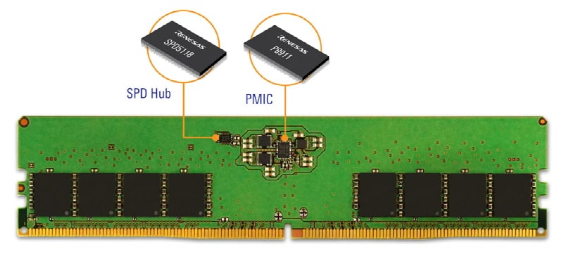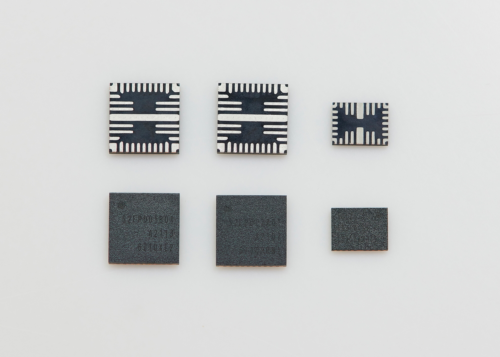According to reports from Electronic Enthusiasts (Author: Zhou Kaiyang), last year Micron and several other memory manufacturers successively launched DDR5 memory. However, due to the high prices of DDR5 memory, which reached thousands on major platforms, coupled with the insufficient support from hardware such as CPUs and motherboards, this first batch of DDR5 memory did not create much of a stir in the market. However, with the recent general decline in DRAM memory prices, DDR5 memory seems to finally have its place. So why was DDR5 memory so expensive at first? Is it really just the high added value brought by new technology?
Difficulty in PMIC Supply
DDR5 has made many improvements based on DDR4, firstly with a higher data rate, increasing from DDR4’s maximum 3200MT/s to DDR5’s maximum 6400MT/s; secondly, it enhances memory stability with an on-chip ECC error correction mechanism and reduces power consumption to a 1.1V voltage. One of the biggest changes in the memory module hardware is the newly added Power Management Integrated Circuit (PMIC).
At higher rates, to pursue greater operational stability, the voltage error of DDR5 cannot exceed ±3%. In DDR4, since the PMIC is on the motherboard, there is inevitably some voltage drop due to the motherboard and interface. The new design allows communication between the CPU and the PMIC on the memory, achieving more precise power management. The presence of the PMIC makes voltage adjustment for DDR5 memory very simple, which is crucial for memory overclocking features like Intel’s XMP 3.0.
Client-grade DDR5 DIMM Memory / Renesas
Furthermore, the power design of the motherboard no longer needs to be controlled based on the number of memory slots, reducing the costs associated with over-design. Some server-grade DDR5 RDMIMM and LRDIMM memory modules have even added temperature sensors for heat monitoring, preventing performance bottlenecks due to overheating.
However, this design brings a problem: the number of PMICs required has increased to the number of installed memory modules. This issue was exacerbated by last year’s semiconductor shortage. Memory manufacturers like Micron have confirmed that the lack of PMICs and other non-memory components has hindered the widespread adoption of DDR5. Reports suggest that the lead time for these DDR5 memory PMICs had reached 35 weeks, but the market expects the situation to improve by 2022, and from the current DDR5 memory prices, it seems to be the case.
Manufacturers Already in the Supply Chain
Although there are many manufacturers in the semiconductor industry that produce PMICs, entering the memory supply chain as a PMIC manufacturer requires some strength, especially since Intel’s 12th generation CPU processor currently provides the most widespread support for DDR5. We will take Intel-validated DDR5 UDIMM (desktop memory) and SODIMM (laptop memory) as examples.
Intel’s validation results include memory from SK Hynix, Samsung, Micron, Kingston, and InnoDisk, with the PMICs used primarily sourced from Renesas, which acquired IDT, a few from MPS, and very few from Taiwan’s MoSys. Some of Samsung’s DDR5 memory uses PMICs from its own LSI division, indicating that Renesas currently dominates the DDR5 memory PMIC market.
In May of last year, Samsung released its DDR5 PMIC solutions, including S2FPD01 and S2FPD02 for server/workstation DDR5 memory and PMIC S2FPC01 for PC-grade DDR5 memory. Among the server-grade PMICs, S2FPD01 is primarily designed for low-density memory modules, while FPD02 is for higher density DDR5 memory, with current load capability management improved from 3A per phase to 5A per phase. S2FPC01, as a PMIC product for PC memory, naturally pursues high efficiency and small packaging, which is why Samsung used a 90nm process for this product.
Renesas had already released the P8911 client-grade DDR5 memory PMIC by the end of 2019, but has not released any other new products since. However, based on Intel’s validation results, it is likely the most commonly used PMIC in consumer-grade DDR5 memory today. Data from AVNET shows that the lead time for Renesas’ client-grade DDR5 memory PMIC P8911 series has been reduced to 26 weeks, indicating that supply issues have indeed improved.
Of course, besides these companies validated by Intel, there are also manufacturers like TI, Lattice Semiconductor, and Richtek Technology, each with their respective DDR5 PMIC solutions. TI’s TPS53830/TPS53832 and Lattice Semiconductor’s M88P5010/M88P5000 are similar to Samsung’s S2FPD01/S2FPD02, designed for different current server DDR5 memory modules, while Richtek Technology’s RTQ5136 is targeted at client-grade DDR5 memory PMIC solutions.
Server-grade is Ready, but Other Hardware is Not Prepared
Recently, Micron released a server-grade DDR5 RDIMM memory with a maximum capacity of 64GB, and Samsung also launched a 512GB CXL DDR5 server memory in May, along with similar products already launched by SK Hynix. DDR5 in servers is certainly gaining momentum.
However, although server-grade DDR5 memory is ready, supporting hardware like server CPUs seems to be lacking. AMD’s next-generation Epyc server chip, Genoa, which supports DDR5 memory, will only be available in the fourth quarter of this year. In contrast, while Intel’s consumer-grade CPUs have already supported DDR5, the server CPU Sapphire Rapids has been delayed again, and it is rumored that mass production may not start until the end of this year.
Therefore, regarding the issue of the low adoption rate of DDR5, it is not solely due to PMICs. It is believed that once Intel and AMD’s server CPUs and consumer CPUs continue to promote DDR5 support, along with various startup companies’ self-developed processors beginning to support DDR5, the price of DDR5 may reach a similar level as DDR4 memory, and its adoption will naturally not be a problem.


Disclaimer: This article is original from Electronic Enthusiasts, please indicate the source above when reprinting. For group discussions, please add WeChat elecfans999, for submission of reports or interview requests, please send an email to [email protected].
More Hot Articles to Read
-
New Energy Vehicle Ownership Exceeds 10 Million! Market Booms in First Half, Favorable Policies Continue
-
There Are Huge Risks Hidden in the Semiconductor Supply Chain
-
Xiaomi Road Test, First Regulation Passed, Accelerating Development of Autonomous Driving, Benefiting the Industry Chain!
-
Wei Brand CEO Criticizes Huawei’s Yu Chengdong, Is Range Extender Behind or Advanced?
-
Geely’s Self-developed 4nm AP Chip, Planning for 2024 Tape-out, Is It to Compete with Apple?



